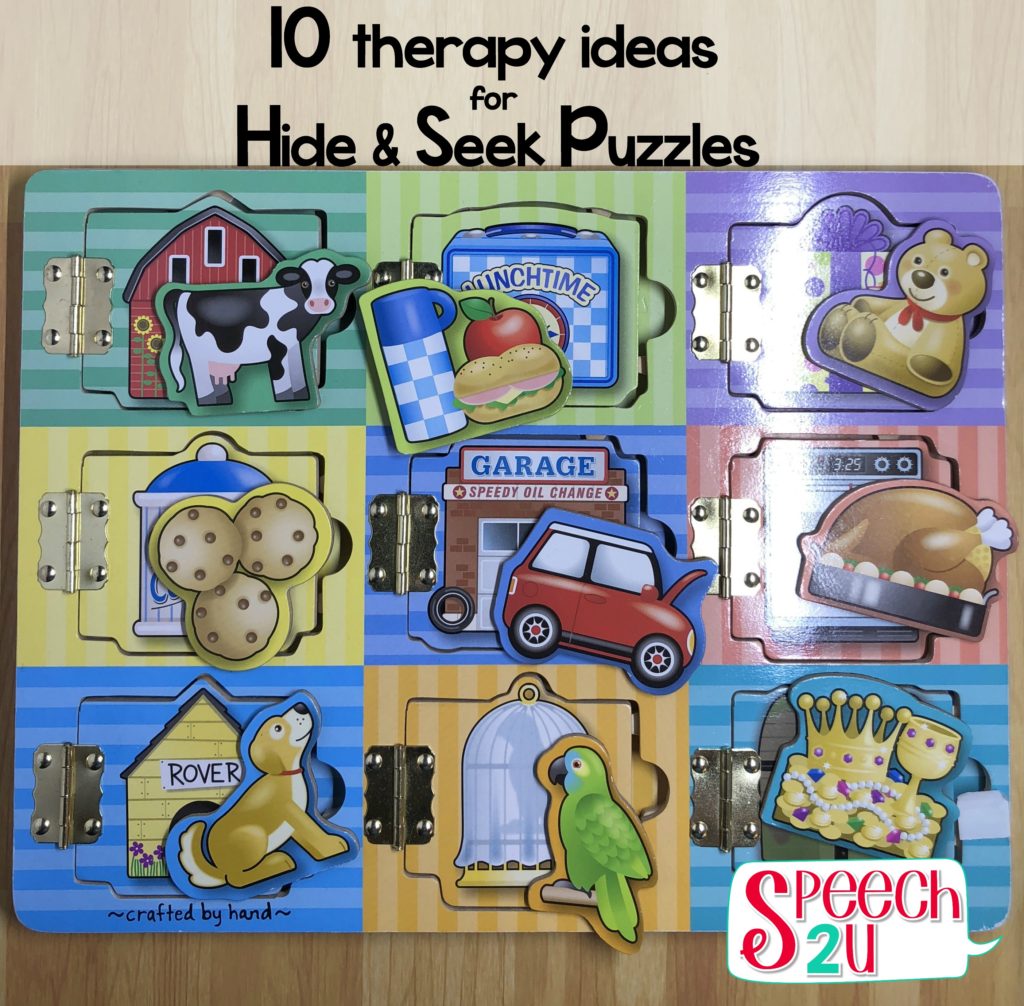It’s Better Hearing and Speech Month and I’m sharing my favorite speech therapy toys, games and books and how I use them in therapy.
Do you like to use puzzles in speech therapy? I love to use the hide and seek puzzles from Melissa and Doug. Each puzzle has a variety of “doors” the client can open. Inside the door is a magnetic piece. These puzzles tend to hold my clients interest a little bit longer than a traditional puzzle and I’m able to target a variety of goals within one session. I have three different ones that I use. One is a farm scene, another has doors and windows and the newest one I just purchased which has containers.
Speech therapy puzzles:
Labeling and Requesting
Duh, right? We all use puzzles to work on labeling and requesting. I might start with I want ________ and then work on question reversals. (Can I have or can I open?). Once we’ve opened the door, I prompt my client to label the object. I usually give a lead in sentence cue “It’s a ______” and then eventually fade my model so they are labeling using the “It’s a _______” carrier phrase. Other carrier phrases I use with this puzzle include:
- I open/You open ______________
- Give me the _________
- Take out/Put in ______________
- Hi/Bye _____________
Sneaky tip: Have you ever worked with a 2-3 year old who is capable of labeling but has difficulty initiating on command, or gets shy when you ask them to label? One trick I use is to hold up two of the magnetic pieces and ask them which one they would prefer? Now it’s a choice they are making rather than expressively labeling.
Receptive Identification
Another no brainer. One benefit to this type of puzzle is that you can work on identifying the containers/doors as well as the magnetic pieces inside. I can ask my client to open the dog house and see if they are able to identify it. Or we can take the magnetic pieces and hide them around the room or put in a box of beans/popcorn. I can ask the client to find the puzzle piece I named. I also work on “testing” vocabulary by varying by requests:
- Point to the _____________
- Find the _______________
- Show me ______________
- Get the ________________
Turn Taking:
I use puzzles to teach inhibition and turn taking. If I let them know that we are taking turns, will they wait and prompt my turn or do they tend to try to open all of the doors themselves? Most of my clients like to do the puzzle themselves. I have to beg them to let me take a turn.
Core vocabulary- verbs:
I work on core vocabulary a lot with my clients, and focus on verbs because they are more abstract but also have so much power once my clients learn how to use them. Here are a few that I can model and target within a hide and seek puzzle activity:
- Open/shut
- Give me piece
- Take the piece
- Put it on/in/back
- I go/you go
- Get the piece
- Close the door
Prepositions:
My therapy room has metal door frames. Once the client has removed the piece, I prompt them to place it on the door frame. (Sometimes we experiment by seeing if the piece will also stick to the door or wall). As they remove more magnets, I model or prompt them to follow directions containing the following concepts:
- Top/bottom
- Which piece is on the top/bottom ?
- Put the ____ on the top/bottom.
- Over/under
- Which piece is over/under the _______?
- Put the _____ over/under the _______.
- In/on
- Which piece is in the box?
- Put the ______ in/on the table/door/box
Answering And Asking Questions:
I use these puzzles to address object function questions and prompt a 3-4 word response. (ex. What is the bird doing? The bird is flying?) Other questions we address in therapy include:
- What is it?
- Where will you put it?
- What will you open?
- Where does it go?
- Who would use it?
- What do you do with it?
- Who should open it? (you/me)
- What do you do with ______?
Pronouns
When we are working on who questions, I am also addressing personal pronouns. Example, if I ask Who should take out the object or who should open the door. I can prompt the client to answer you or me. I can then encourage them to model the phrase I take the ________.
Asking Questions:
When I hide the magnets around the room, I can work on question forms by having my client ask me where I put it or ask simple yes/no questions (Is it in the water?).
Predicting:
Once the child is familiar with the puzzle we can work on predicting. What do you think will be under this door? It’s fun to hide different magnets under the door and see if they can use their protesting skills to alert you to the change.




